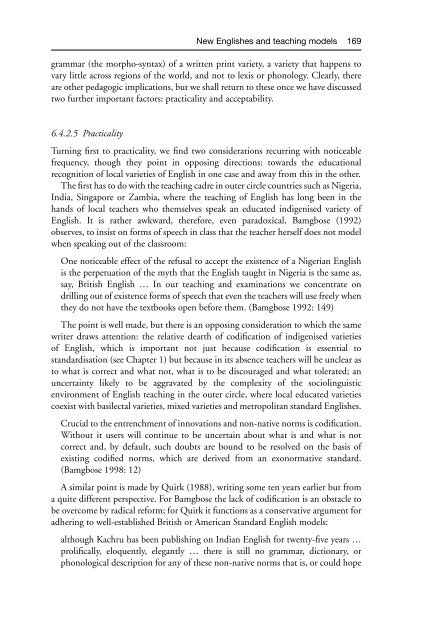Gibson Ferguson Language Planning and Education Edinburgh ...
Gibson Ferguson Language Planning and Education Edinburgh ...
Gibson Ferguson Language Planning and Education Edinburgh ...
You also want an ePaper? Increase the reach of your titles
YUMPU automatically turns print PDFs into web optimized ePapers that Google loves.
New Englishes <strong>and</strong> teaching models 169<br />
grammar (the morpho-syntax) of a written print variety, a variety that happens to<br />
vary little across regions of the world, <strong>and</strong> not to lexis or phonology. Clearly, there<br />
are other pedagogic implications, but we shall return to these once we have discussed<br />
two further important factors: practicality <strong>and</strong> acceptability.<br />
6.4.2.5 Practicality<br />
Turning first to practicality, we find two considerations recurring with noticeable<br />
frequency, though they point in opposing directions: towards the educational<br />
recognition of local varieties of English in one case <strong>and</strong> away from this in the other.<br />
The first has to do with the teaching cadre in outer circle countries such as Nigeria,<br />
India, Singapore or Zambia, where the teaching of English has long been in the<br />
h<strong>and</strong>s of local teachers who themselves speak an educated indigenised variety of<br />
English. It is rather awkward, therefore, even paradoxical, Bamgbose (1992)<br />
observes, to insist on forms of speech in class that the teacher herself does not model<br />
when speaking out of the classroom:<br />
One noticeable effect of the refusal to accept the existence of a Nigerian English<br />
is the perpetuation of the myth that the English taught in Nigeria is the same as,<br />
say, British English … In our teaching <strong>and</strong> examinations we concentrate on<br />
drilling out of existence forms of speech that even the teachers will use freely when<br />
they do not have the textbooks open before them. (Bamgbose 1992: 149)<br />
The point is well made, but there is an opposing consideration to which the same<br />
writer draws attention: the relative dearth of codification of indigenised varieties<br />
of English, which is important not just because codification is essential to<br />
st<strong>and</strong>ardisation (see Chapter 1) but because in its absence teachers will be unclear as<br />
to what is correct <strong>and</strong> what not, what is to be discouraged <strong>and</strong> what tolerated; an<br />
uncertainty likely to be aggravated by the complexity of the sociolinguistic<br />
environment of English teaching in the outer circle, where local educated varieties<br />
coexist with basilectal varieties, mixed varieties <strong>and</strong> metropolitan st<strong>and</strong>ard Englishes.<br />
Crucial to the entrenchment of innovations <strong>and</strong> non-native norms is codification.<br />
Without it users will continue to be uncertain about what is <strong>and</strong> what is not<br />
correct <strong>and</strong>, by default, such doubts are bound to be resolved on the basis of<br />
existing codified norms, which are derived from an exonormative st<strong>and</strong>ard.<br />
(Bamgbose 1998: 12)<br />
A similar point is made by Quirk (1988), writing some ten years earlier but from<br />
a quite different perspective. For Bamgbose the lack of codification is an obstacle to<br />
be overcome by radical reform; for Quirk it functions as a conservative argument for<br />
adhering to well-established British or American St<strong>and</strong>ard English models:<br />
although Kachru has been publishing on Indian English for twenty-five years …<br />
prolifically, eloquently, elegantly … there is still no grammar, dictionary, or<br />
phonological description for any of these non-native norms that is, or could hope






